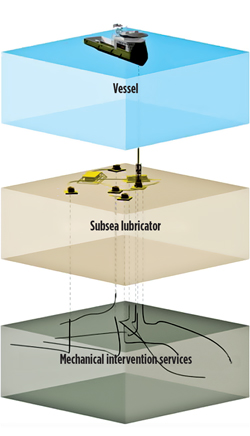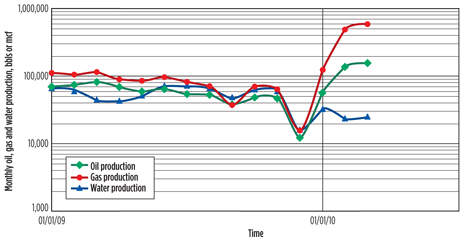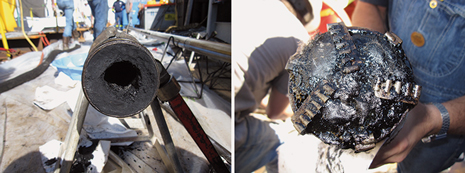BEVAN MORRISON, Subsea Intervention Services, Welltec A/S
 |
| Welltec‘s Well Cutter electric-line intervention tool uses grinding pads made of a metal matrix composite with embedded diamonds. |
|
Global production is declining, while worldwide energy consumption is increasing. The average recovery factors on subsea wells globally is approximately 22%, meaning subsea wells produce 10% to 30% less than equivalent dry tree wells, on a global basis.
These are not new or surprising facts, but together they do point to a very clear need to better utilize and enhance the production of current oil fields across the globe. Targeting that 70-80% of oil left in the ground, Welltec has developed a suite of electric line intervention tools to allow operators to further enhance production of existing assets.
CHALLENGE: IMPROVING PRODUCTION FROM SUBSEA WELLS
A combination of increasing global energy demand, known reserves being depleted, and the offshore locations of new oil and gas discoveries, is pushing drilling and production into deeper and deeper waters. Technology advances, coupled with the ever-present need to reduce operating costs, especially offshore, have driven an increase in the use of subsea wells. At the end of 2011, the total number of subsea wells was estimated to be 5,500.
One of the major problems with subsea wells is that recovery factors are much lower—typically 10% to 30% less—compared to recovery rates of dry-tree, platform-based wells. A key reason for this difference is that workover activities to improve recovery rates in subsea wells have traditionally required use of large, expensive rigs. The high costs of these operations can make it difficult to achieve the necessary increases in production rates and revenue to justify the workover investment.
 |
| Fig. 1. Rig-less electric-line intervention from a mono hull vessel. |
|
These challenges drove the development of rig-less and riserless light well interventions (RLWI) from mono-hull vessels, improving scheduling flexibility, and reducing costs and the development of specialized electric-line deployed intervention services that can be run from these vessels instead of a drilling rig, Fig. 1.
CASE HISTORIES
Welltec has been involved in RLWI operations for the last 13 years and continues to introduce new mechanical intervention tools. These services enable the increased recovery from subsea wells, they have also set numerous world records and achievments clearly demonstrating the benefits of RLWI, in general.
Production enhancement in deepwater subsea well utilizing electric line technology. ATP Oil & Gas had been producing from multiple zones in Mississippi Canyon Block 711, No. 4 well, since 2005. The cost to intervene on this well with a drilling rig was prohibitive, so a number of specialist intervention contractors were engaged with the intervention goal to commingle a mostly oil-bearing zone with a mainly gas-bearing zone to maximize the recovery rates. The intervention contracting team was made up of Welltec for (downhole tooling) Wrights Well Control (electric line), Blue Ocean (subsea lubricator) and Global Industries (Olympic Challenger) and Hornbeck Offshore (HOS Iron Horse) for the dynamically positioned vessels used across the two well projects. The intervention required was to shift a sleeve to allow the mostly gas-bearing zone to be comingled with the mostly oil-bearing zone.
During test runs, a restriction was found, preventing the toolstring from reaching the required depth to shift the sleeve. Welltec utilized the power suction tool (PST) to clean the restriction, but it was found that the blockage was essentially paraffin and sand. The PST is ideally designed for sand and solid debris, not paraffin, so the operator then ran a well miller with a special milling bit, which had been on standby for such problems, to clear the restrictions. In all, ATP deployed the Well Cleaner and Well Miller, both of which had been contingency tools, given the need to reach the sleeve depth to achieve the intervention result. Finally, after cleaning out the paraffin and sand, the service company rigged up the well stroker together with the well tractor and successfully tractored to 11,400 ft and opened the sleeve to commingle the two zones.
 |
| Fig. 1. Rig-less electric-line intervention from a mono hull vessel. |
|
After the 14 intervention runs were completed on Jan. 23, 2010, gas production from the well was seen to have increased 800%, oil production increased 300%, and water production dropped to 30% of the October rates, Fig. 2.
 |
| Fig. 2. After 14 intervention runs, oil and gas production increased, and water production decreased. |
|
Contingency planning is critical for subsea wells, because they are often not entered on a regular basis, and the downhole conditions are not always known. Equipment, such as the power suction tool and well miller, which can mill scale, paraffin, ashphaltene, ball valves, nipple profiles and flapper valves, all on electric line, proved to be a critical part of the success of this subsea intervention.
 |
| Fig. 3. An electric-line clean-out tool with a tungsten bit was used to break up a hydrate obstruction. |
|
World’s first electric line hydrate milling, riserless in a subsea well (BP 2012). A water injection well offshore the UK was undergoing a start-up procedure, when a buildup in the wellhead cavity was observed, indicating a possible blockage by hydrates. Methane injections cleared the hydrate in the flow valve and valve wing, but not the hydrate below the subsea tree, and its length was unknown. Several technology alternatives were considered and deliberated, including: heat transference, a combination of heat and milling, and straight milling. In the end, the service provider’s electric line clean-out tool designed with a reverse circulating bit, was selected with a tungsten bit to break up the hydrates, Fig. 3.
This tool provided circulation and suction while milling to capture debris. The toolstring also included a well tractor that was used to counteract the torque of the milling tool. The operation was run from a mono-hull intervention vessel, and it was the first-ever rigless intervention conducted in these waters. The successful operation milled 173 ft in four runs, in just under 20 hr of active milling, with an average rate of penetration (ROP) of 1 m/minute, to a depth that allowed the operator to re-establish functionality to the downhole safety valve.
Since this first successful RLWI, many more such operations have been run in this area with an average annual objective success rate of 90%.
Record water depth achieved during first milling of ashphaltenes on electric line. An operator in the Gulf of Mexico planned to set a lock-open sleeve across a failed subsurface safety valve (SSV) on one of its subsea wells. The well had not been re-entered since it began production, so little was known of the downhole conditions. During the slickline gauge run, the toolstring hung up after only 1,000 ft in the well and could not be jarred any deeper. After multiple attempts, the well tractor, and a well cleaner designed with a reverse circulating bit, were run in-hole to mill through the obstruction.
The new toolstring was able to tractor past the previous hang-up depth (HUD) of slickline and continued in to 5,727 ft, where a blockage was encountered. The well miller was engaged, and after milling 5 ft of unknown fill, the toolstring became stuck, but it was eventually worked free and brought back to surface, where the bit was found to be clogged and packed with solid debris. The bailer sections were found to be full of dense, hard-packed ashphaltenes, which had not been at all anticipated in the well.
Based on this recovery, the operator was able to avoid further costs, and, the firm suspended operations until they had fully analyzed the samples and determined how best to accomplish the removal. This operation was achieved in a world-record-setting water depth for electric line operations of 3,991 ft. It was the first time that asphaltenes had been milled using electric-line milling technology.
Milling and cleaning hard-packed debris and removing a bridge plug (Delot, Eikeland et al. 2012). An intervention job to repair a leak in a vertical subsea tree on a North Sea well required a temporary bridge plug, to be installed as a production barrier. While the well was being serviced, scale was inadvertently being scraped off the inside of the tubing, and the debris fell down the hole and accumulated on top of the bridge plug, preventing it from being pulled. Riserless slickline, and traditional electric line intervention solutions were unsuccessful at removing it. The wait time for a coiled tubing (CT) rig to perform the task was over one year. Thus, the operator needed alternative solutions to clean the debris, pull the plug and get the well back on production.
 |
| Fig. 4. An electric-line clean-out tool and a high-powered vacuum system were used to break up and remove hard, compacted debris. |
|
To perform this operation, they chose the provider’s electric line clean-out technology, which features a reverse circulating bit to break up hard, compacted debris, and a high-powered vacuum system with bailers to suction debris and bring it to the surface, Fig. 4. The toolstring also included an electric-hydraulic stroking tool, combined with a modified flow-through GS pulling tool, to suck remaining debris from the internal profile, allowing the GS profile to be engaged and to release and retrieve the plug after the debris was removed. The operation was successfully executed—debris cleaned and the bridge plug pulled—in one run from a small RLWI vessel, saving the operator from a year of deferred production waiting for a CT unit.
OBJECTIVES TO RLWI SETTLED
Barriers to using RLWI have been removed in the industry, and the technology continues to advance. In just the last five years, because of advances in vessel and deployment technologies, the depth at which RLWI is being conducted has more than tripled, with electric line operations now being conducted at 1,000-plus-m depths. Also, more electric line, lightweight well intervention technologies and services continue to be developed and commercialized, helping operators solve a broader range of well problems and challenges. The combination of these advancements is making it safer, more reliable, and more cost-effective to perform subsea well interventions, and to perform them more frequently to continuously improve recovery rates.
Despite these recent record achievements with RLWI, in this post-peak-oil, brown-field era, service companies need operator involvement and commitment to continue to advance and expand the global use of this technology to meet the burgeoning global demand for energy and to aid in recovering the 78% of oil left sub-surface. 
|







